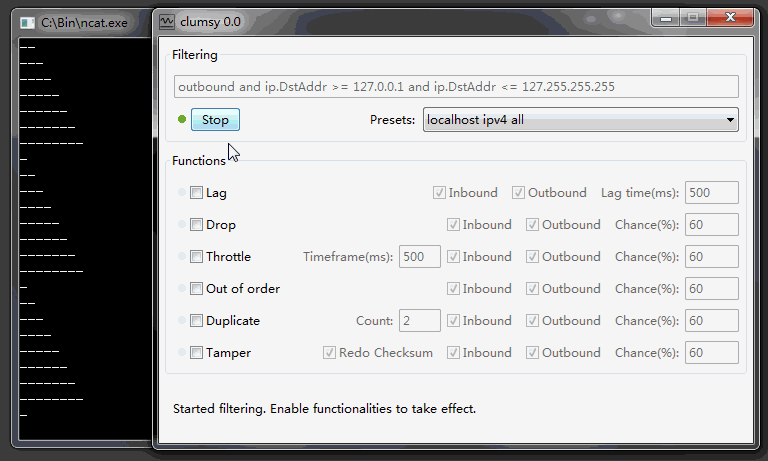您现在的位置是:网站首页 -> 底层开发 文章内容
模拟差网络环境的软件-itarticl.cc-IT技术类文章记录&分享
发布时间: 8年前【底层开发】 194人已围观【返回】
clumsy will choose which packets to capture by given filter, in which in can specify whether it's inbound or outbound, tcp or udp, socket port or ip, or a logical combination of many of those criterias. When started clumsy will only capture packets based on the filter, leaving others untouched.
After packets are captured, you can choose to enable provided functions to worsen perspective network condition:
Lag, hold the packets for a short period of time to emulate network lagging.
Drop, randomly discard packets.
Throttle, block traffic for a given time frame, then send them in a single batch.
Duplicate, send cloned packets right after to the original one.
Out of order, re-arrange the order of packets.
Tamper, nudge bits of packet's content.
Though nowadays it seems everybody have high speed broadband Internet connection, it's still important to face the fact that network transportation isn't always reliable. You don't want a duplicated UDP packet to crash your application. Properly handle this usually requires adding more code in their projects, and it's not always easy nor possible. Hopefully clumsy can provide an easy and painless (though suboptimal) option to do this for busy developers.
The project repository is on github https://github.com/jagt/clumsy . Download clumsy here http://jagt.github.io/clumsy/download.html. But before you actually use it, be sure to read the manual to know its capabilities and limitations.

发布时间: 8年前【底层开发】194人已围观【返回】【回到顶端】
很赞哦! (1)
上一篇:NAT的特殊处理
下一篇:TPS和QPS的区别
相关文章
点击排行
 单一职责原则、里氏替换原则、依赖倒置原则
单一职责原则、里氏替换原则、依赖倒置原则站长推荐
 接口隔离原则、迪米特法则、开闭原则
接口隔离原则、迪米特法则、开闭原则猜你喜欢
站点信息
- 建站时间:2016-04-01
- 文章统计:728条
- 文章评论:82条
- QQ群二维码:扫描二维码,互相交流














